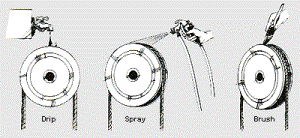How long will your rope last? There
is not a simple answer but, rather,
there are several factors involved,
including:
- The manner in which you install
and "break in " your new
rope
- The operating technique and
work habits of the machine operators
- Physical maintenance of the
rope throughout its service life
- Physical maintenance of the
system in which your rope operates
We've outlined several recommended
practices you may use to extend your
rope's useful life.
Install your rope correctly.
The primary concern when installing
a new rope is to not trap any twist
in the rope system. Proper handling
of the rope from the reel or coil
to your equipment will help avoid
this situation. Another important
step on smooth faced drums is to spool
with wraps tight and close together
on the first layer. This layer forms
the foundation for succeeding layers.
Finally, spool the remaining rope
on the drum with tension approximating
1% to 2% of the rope's minimum breaking
force.
Break in your new rope properly.
When you install a new operating rope,
you should first run it for a brief
period of time with no load. Then,
for best results, run it under controlled
loads and speeds to enable the wires
and strands in the rope to adjust
to themselves.
"Constructional"
stretch. When first
put into service, new ropes normally
elongate while strands go through
a process of seating with one another
and with the rope core. This is called
"constructional" stretch
because it is inherent in the construction
of the rope, and the amount of elongation
may vary from one rope to another.
For standard ropes, this stretch will
be about 1/4% to 1% of the rope's
length. When constructional
stretch needs to be minimized, ropes
may be factory prestretched. Please
specify when placing your order.
Another type of stretch, "elastic"
stretch, results from recoverable
deformation of the metal itself. For
more information, please refer to
the WRCA Wire Rope Technical Data
Handbook.
Cut off ends to move wear
points. If you observe
wear developing in a localized area,
it may be beneficial to cut off short
lengths of rope. This may require
an original length slightly longer
than you normally use. When severe
abrasion or numerous fatigue breaks
occur near one end or at any one concentrated
area -- such as drag ropes on draglines
or closing lines in clamshell buckets,
for example -- the movement of this
worn section can prolong rope life.
Wire breaks from vibration fatigue
occur at end terminations, so short
lengths cut off there with reattachment
of the socket may prolong the rope's
life. When broken wires are found,
you should cut off sections of rope.
In the case of a socket, you should
cut off at least five or six feet.
In the case of clips or clamps, you
should cut off the entire length covered
by them.
Where there is an equalizing sheave,
such as that found in many overhead
cranes, fatigue is localized at rope
tangency points to the equalizing
sheave. Rope life will be increased
if you shift this point by cutting
off a short length at the end of one
of the drums. Be sure to make this
cutoff before significant wear occurs
at the equalizing sheave, and always
do so at the same drum.
Reversing ends.
Frequently, the most severe deterioration
occurs at a point too far from the
end or is too long to allow the worn
section to be cut off. In such cases,
you may turn the rope end for end
to bring a less worn section into
the area where conditions are most
damaging. This practice is beneficial
for incline rope and draglines. The
change must be made well before the
wear reaches the removal criteria.
When changing ends, be careful to
avoid kinking or otherwise damaging
the rope.
Lubrication.
We lubricate our wire rope during
manufacture so that the strands --
as well as the individual wires in
the strands -- may move and adjust
as the rope moves and bends. But no
wire rope can be lubricated sufficiently
during manufacture to last its entire
life. That's why it's important to
lubricate periodically throughout
the life of the rope.
The surface of some ropes may become
covered with dirt, rock dust or other
material during their operation. This
can prevent field-applied lubricants
from properly penetrating into the
rope, so it's a good practice to clean
these ropes before you lubricate them.
The lubricant you apply should be
light-bodied enough to penetrate to
the rope's core. You can normally
apply lubricant by using one of three
methods: drip it on rope, spray it
on or brush it on. In all cases, you
should apply it at a place where the
rope is bending such as around a sheave.
We recommend you apply it at the top
of the bend because that's where the
rope's strands are spread by bending
and more easily penetrated. In addition,
there are pressure lubricators available
commercially. Your rope's service
life will be directly proportional
to the effectiveness of the method
you use and the amount of lubricant
that reaches the rope's working parts.

A proper lubricant must reduce friction,
protect against corrosion and adhere
to every wire. It should also be pliable
and not crack or separate when cold
yet not drip when warm. Never apply
heavy grease to the rope because it
can trap excessive grit, which can
damage the rope. Nor should you apply
used "engine oil" because
it contains materials that can damage
the rope. For unusual conditions,
you can specify special lubricants
that we can apply at the factory.
� |